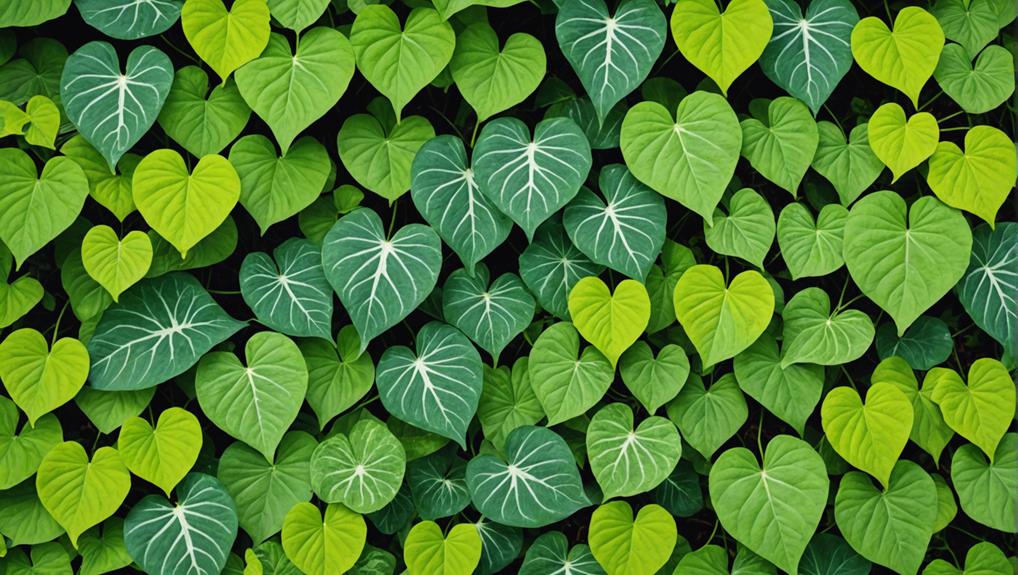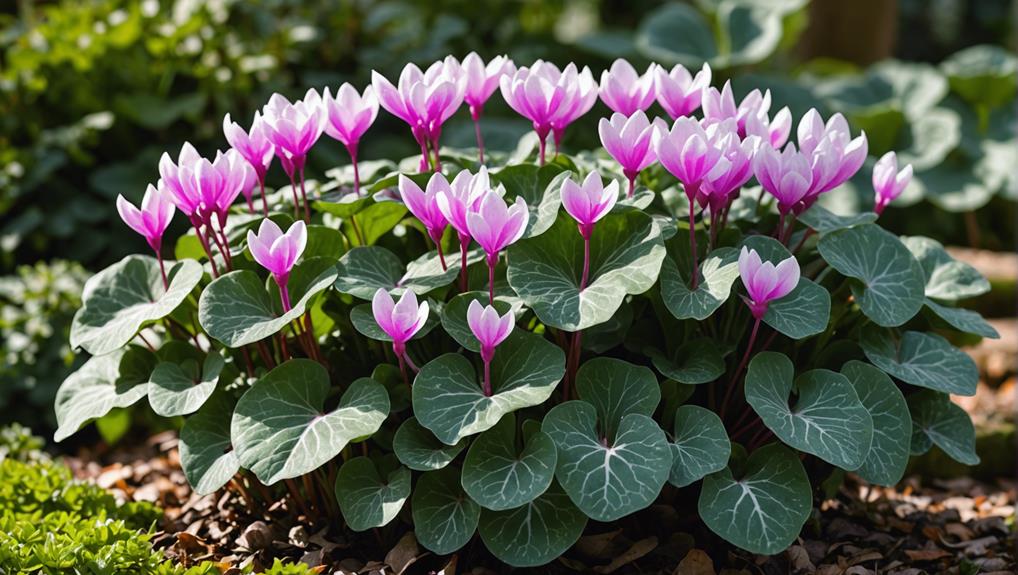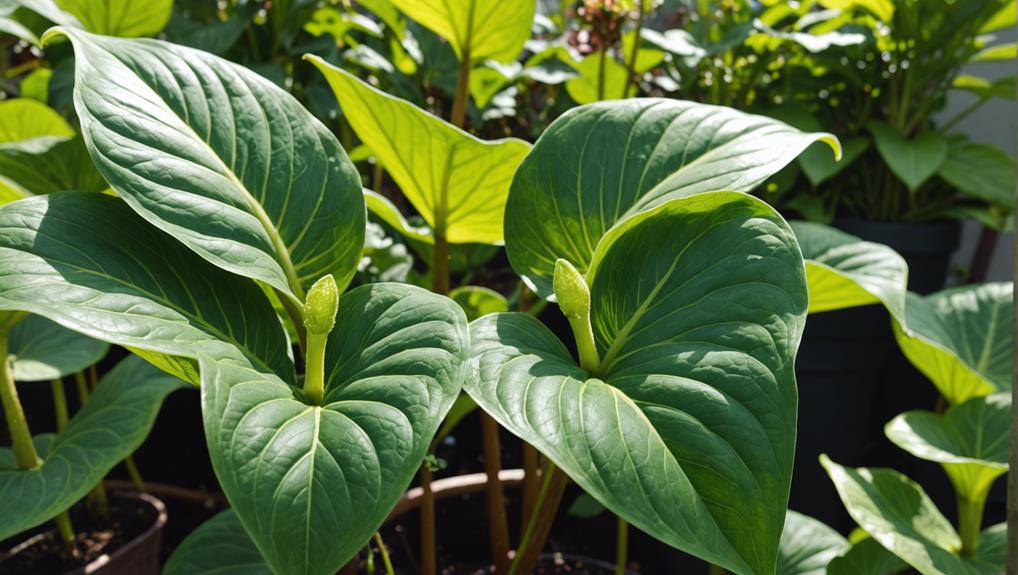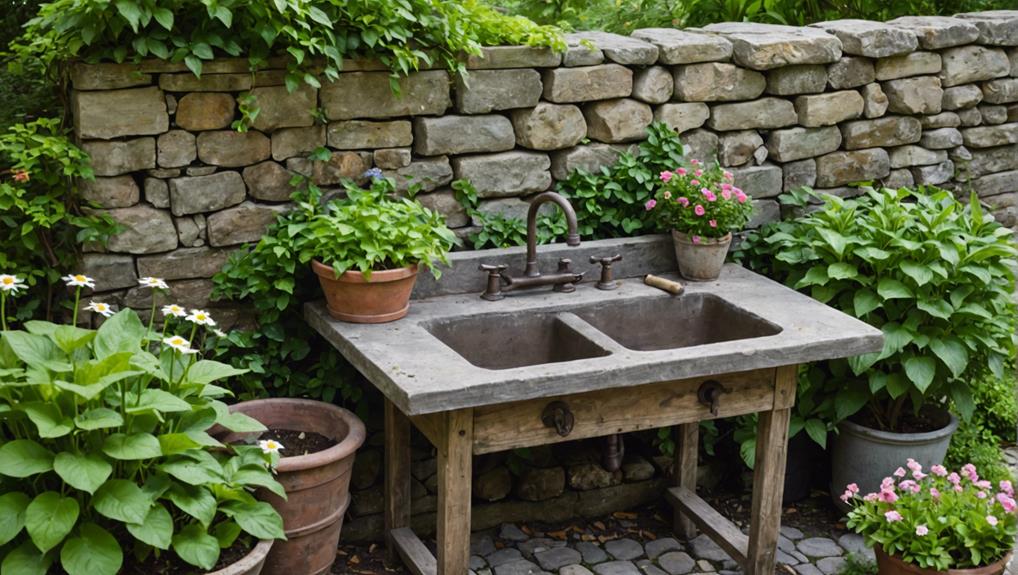
Discover 10 Stunning Outdoor Plants With Heart-Shaped Leaves
Discovering outdoor plants with heart-shaped leaves can enhance the visual appeal of your garden with both vibrant colors and unique textures. Bleeding Heart and Caladium thrive in shaded, moist environments, while the Redbud tree and Anthurium offer enchanting blossoms. Hosta and Elephant Ear add lush, varied foliage, thriving in partial to full shade. Cyclamen impresses with winter blooms and intricate leaf variegation, and Betel Pepper offers aromatic qualities for tropical themes. Dutchman's Pipe and the towering Foxglove Tree contribute significant visual interest and shade. Each plant offers distinct features and care needs, promising to enrich any landscape further.
Key Takeaways
- Bleeding Heart thrives in partial to full shade with heart-shaped flowers in pink and white.
- Redbud is a deciduous tree with heart-shaped leaves and vibrant pink flowers in early spring.
- Hosta features large, heart-shaped leaves and thrives in partial to full shade.
- Elephant Ear offers enormous heart-shaped leaves and is suitable for USDA Zones 8-11.
- Dutchman's Pipe requires vertical support and showcases distinctive heart-shaped leaves.
Bleeding Heart
Bleeding Heart (Dicentra spectabilis) is a perennial plant renowned for its distinctive heart-shaped flowers that exhibit vibrant shades of pink and white. These unique blossoms hang gracefully from arching stems, reminiscent of delicate earrings, and are often associated with heart-shaped symbolism, invoking themes of love and romance. Thriving in partial to full shade, this plant requires moist, well-draining soil to flourish.
For best growth, Bleeding Heart should be planted in a location that avoids direct midday sun, as excessive heat can lead to wilting. Incorporating organic matter into the soil can enhance moisture retention and nutrient availability. During the growing season, regular watering is important, especially during dry spells.
Companion planting with shade-tolerant species such as hostas, ferns, and astilbes can create a visually appealing and ecologically balanced garden bed. These plants can help maintain soil moisture and provide a layered aesthetic. Seasonal care involves mulching in early spring to retain soil moisture and applying a balanced fertilizer to promote robust growth.
Understanding the growing tips and seasonal care requirements of Dicentra spectabilis is essential for maintaining its health and beauty, ensuring that its iconic flowers continue to enchant garden landscapes.
Caladium
Shifting focus from the delicate flowers of Dicentra spectabilis, Caladium captivates with its vibrant, heart-shaped foliage that thrives in hot and humid conditions, making it an ideal choice for enhancing the visual appeal of warmer climate gardens. Known for their striking leaf color variations, Caladium leaves exhibit an array of hues including red, pink, and white, often with intricate leaf pattern designs that add an element of sophistication to any landscape.
In terms of care, Caladiums flourish in well-drained, fertile soils and require consistent moisture to maintain their vivid appearance. For those interested in indoor cultivation, these plants can be grown indoors provided they receive bright, indirect light and high humidity levels. Regular misting and the use of a humidifier can help replicate their natural tropical environment.
| Characteristic | Details |
|---|---|
| Leaf Color Variations | Red, Pink, White |
| Leaf Pattern Designs | Intricate, Multi-hued |
| Preferred Climate | Hot and Humid |
| Soil Requirements | Well-drained, Fertile |
| Indoor Cultivation Tips | Bright, Indirect Light, High Humidity |
The dramatic size of Caladium leaves, often larger than the palm of your hand, makes them a focal point in garden design. Their unique foliage not only enhances outdoor spaces but also brings a touch of tropical elegance to indoor settings.
Redbud
The Redbud (Cercis canadensis) stands out as a deciduous tree renowned for its distinctive heart-shaped leaves and vibrant pink flowers that emerge in early spring, offering both ecological benefits and aesthetic appeal to diverse landscapes. Thriving in USDA Hardiness Zones 5 to 9, the Redbud tree reaches a mature height of 20 to 30 feet with a spread of 25 to 35 feet. This species prefers full sun to partial shade, making it versatile for various garden settings.
Redbud trees are not only visually striking but also beneficial to local ecosystems. Their flowers attract pollinators such as bees and butterflies, contributing to the health of surrounding flora.
- Height and Spread: Reaches 20 to 30 feet in height, 25 to 35 feet in spread.
- Growing Conditions: Thrives in full sun to partial shade.
- Ecological Benefits: Attracts pollinators like bees and butterflies.
- Aesthetic Appeal: Features vibrant pink flowers and heart-shaped leaves.
Effective Redbud tree pruning is essential for maintaining its shape and promoting healthy growth. Various Redbud tree landscaping ideas include using it as a focal point in garden designs or as a natural privacy screen. Proper care and placement can greatly enhance the beauty and functionality of outdoor spaces.
Anthurium
Anthurium, often referred to as the flamingo flower, is distinguished by its striking heart-shaped leaves that come in vibrant hues of red, pink, or white. The plant's tropical charm and unique foliage make it an elegant addition to any garden space. Anthurium thrives in bright indirect light and requires specific humidity levels for best growth. It is known for blooming multiple times a year with long-lasting flowers, adding to its allure.
Anthurium care involves maintaining consistent moisture, but avoiding waterlogged soil. The plant is easy to propagate through stem cuttings, making it accessible for both novice and experienced gardeners. Anthurium's symbolism, often associated with hospitality and love, makes it an ideal gift for occasions such as Valentine's Day.
There are numerous Anthurium varieties, each with unique characteristics, enhancing the plant's decorative versatility. Whether used in indoor or outdoor settings, Anthurium's vibrant colors and heart-shaped leaves create a visually stunning display.
| Aspect | Details | Importance |
|---|---|---|
| Light Requirement | Bright indirect light | Essential for growth |
| Watering | Consistent moisture, avoid waterlogging | Prevents root rot |
| Propagation | Stem cuttings | Easy for gardeners |
| Symbolism | Love, hospitality | Ideal for gifting |
| Varieties | Multiple, unique characteristics | Decorative versatility |
Hosta
Often celebrated for their robust and attractive foliage, Hosta plants, also known as plantain lilies, are herbaceous perennials distinguished by their large, heart-shaped leaves. Thriving in partial to full shade, Hostas are ideal for shaded garden areas or under trees, contributing greatly to Hosta garden design. Their diverse color palette, ranging from deep blue to vibrant green, as well as variegated patterns, adds a dynamic visual interest to garden landscapes.
Hostas are not only aesthetically pleasing but also practical, as they are low-maintenance and tolerate various soil conditions. This adaptability makes them versatile additions to outdoor gardens. Beyond their foliage, Hostas produce delicate, bell-shaped flowers on tall spikes during summer, enhancing their ornamental value.
Key attributes of Hosta plants include:
- Foliage: Large, heart-shaped leaves available in multiple colors and patterns.
- Light Requirements: Thrive in partial to full shade, perfect for shaded garden areas.
- Maintenance: Low-maintenance with tolerance for different soil conditions.
- Flowers: Bell-shaped blooms on tall spikes that appear in summer.
Proper Hosta leaf care involves ensuring adequate moisture without waterlogging, controlling slugs and snails, and periodically dividing the clumps to maintain vigor and prevent overcrowding, thereby optimizing their contribution to Hosta garden design.
Elephant Ear
Complementing the shaded elegance of Hostas, Elephant Ear plants (Colocasia esculenta) stand out with their enormous, heart-shaped leaves that can reach up to 3 feet in length and 2 feet in width, bringing a bold, tropical flair to any garden landscape. These perennial plants thrive in USDA Hardiness Zones 8-11 and prefer moist, well-draining soil with partial shade to full sun conditions. Their dramatic foliage is not only visually striking but also plays a functional role in creating lush, exotic garden spaces.
Elephant Ear plants are relatively low-maintenance, making them a practical choice for both novice and experienced gardeners. Indoor propagation through the division of rhizomes guarantees continuous growth and allows for the cultivation of various variegated varieties. These variegated types offer unique leaf patterns, adding further interest to garden compositions.
For those with limited outdoor space, container gardening presents an excellent alternative for growing Elephant Ears. Large pots or planters can accommodate their substantial root systems while allowing flexibility in positioning, whether on patios or balconies.
In landscape designs, Elephant Ears can serve as focal points or be used to create dynamic layers, enhancing the visual depth and texture of garden environments.
Cyclamen

Cyclamen, scientifically known as Cyclamen persicum, showcases heart-shaped leaves adorned with intricate variegation and vibrant hues, making it a striking addition to both indoor and outdoor gardens. This perennial plant is celebrated not only for its decorative foliage but also for its elegant blooms that appear in winter or spring. The flowers come in a captivating array of colors, including pink, white, and red, enhancing its visual appeal.
Successful Cyclamen care involves maintaining cool temperatures and providing indirect but bright light, conditions that mimic its natural habitat. Ensuring a well-drained soil mix is essential to prevent root rot. Regular watering is important, but care must be taken to avoid waterlogging, which can be harmful to the plant.
Varieties: Cyclamen persicum has numerous varieties, each offering unique leaf patterns and flower colors.
Colors: Flowers range from deep reds to pristine whites, and vibrant pinks.
Propagation: Typically propagated through tuber division or seeds, requiring a meticulous approach to promote healthy growth.
Reblooming: With proper care, Cyclamen can rebloom year after year, offering continuous beauty.
Cyclamen's enchanting foliage and flowers make it a versatile choice for enhancing the aesthetic appeal of any garden space.
Betel Pepper
Betel Pepper (Piper betle) is distinguished by its glossy, heart-shaped leaves, which not only add visual appeal but also possess aromatic qualities.
Peak growth of this perennial plant is achieved under warm, humid conditions, aligning with its USDA Hardiness Zone 4 classification.
This species thrives in tropical-themed gardens and can adapt to being a houseplant in colder climates, highlighting its versatility and cultural significance.
Unique Leaf Characteristics
Renowned for its glossy, dark green, heart-shaped leaves, Piper betle exhibits a unique morphology that combines both aesthetic appeal and functional utility in traditional medicine and culinary practices. The heart-shaped foliage of Betel Pepper is not just visually striking but also steeped in plant symbolism, often signifying love and prosperity in various cultures. This makes it a coveted addition to ornamental gardens.
The leaves of Piper betle are characterized by their smooth, waxy surface, which not only enhances their visual allure but also serves a predominant role by reducing transpiration. Additionally, while the leaves are mainly dark green, subtle leaf variegation can occur, adding a layer of complexity and making it a topic of interest in contemporary gardening trends.
Here are some key characteristics of Betel Pepper leaves:
- Glossy Surface: Enhances visual appeal and reduces water loss.
- Heart-Shaped Foliage: Symbolizes love and prosperity, making it popular in ornamental gardening.
- Aromatic and Peppery Flavor: Adds culinary and medicinal value.
- Subtle Variegation: Introduces an element of intrigue in modern garden aesthetics.
The unique leaf characteristics of Piper betle make it a multifaceted plant that appeals to both practical and decorative gardening enthusiasts.
Ideal Growing Conditions
Exploring the unique leaf characteristics of Piper betle naturally leads us to contemplate the essential growing conditions necessary for these features to thrive. Betel Pepper, a perennial plant, thrives ideally in USDA hardiness zones 10-11, where the climate is warm and humid. It prefers well-draining soil with a slightly acidic to neutral soil pH, typically ranging from 5.5 to 7.0. Ensuring proper soil drainage is pivotal to prevent root rot and other fungal infections.
The plant flourishes under partial shade, receiving filtered sunlight exposure for approximately 4-6 hours daily. Direct, intense sunlight can scorch the leaves, while too little light can impede growth. Watering frequency should be adjusted according to the season; during the growing phase, consistent moisture is vital, but overwatering must be avoided to prevent waterlogging.
Fertilizer needs for Betel Pepper include a balanced, slow-release fertilizer applied bi-monthly during the growing season. This guarantees that the plant receives the necessary nutrients without the risk of nutrient burn. Additionally, organic compost can be incorporated to enrich the soil.
Regular monitoring and adjustments based on environmental conditions will ensure the vibrant growth and health of Piper betle's heart-shaped leaves.
Dutchman's Pipe

Dutchman's Pipe (Aristolochia macrophylla) is distinguished by its heart-shaped leaves, which can contribute greatly to the aesthetic appeal of outdoor spaces.
This climbing plant thrives in USDA Zones 4-8, achieving best growth when exposed to full or partial sunlight.
Its ability to grow up to 30 feet long and cover substantial areas makes it an excellent choice for enhancing garden structures such as fences and trellises.
Unique Leaf Structure
Characterized by its large, heart-shaped leaves, Aristolochia macrophylla, commonly known as Dutchman's Pipe, exhibits a unique leaf structure marked by dark green coloration and prominent venation. This striking plant, renowned for its heart shaped vines, serves as an excellent example of botanical heart motifs, often symbolizing love and affection in various cultural contexts.
The leaf structure of Dutchman's Pipe is not merely ornamental; it plays a crucial role in the plant's physiological functions. The broad surface area of each leaf maximizes photosynthetic efficiency, while the prominent venation plays a pivotal role in ensuring effective nutrient and water transport throughout the plant. This intricate leaf structure symbolism has positioned Dutchman's Pipe as a trendsetter in heart shaped foliage trends among garden enthusiasts.
Key features of Dutchman's Pipe's unique leaf structure include:
- Large, heart-shaped leaves: These expansive leaves create a lush, verdant canopy.
- Dark green coloration: The deep hue adds a rich aesthetic to garden landscapes.
- Prominent venation: Visible veins highlight the leaf's structure and functionality.
- Deciduous nature: Seasonal leaf shedding contributes to the plant's lifecycle management.
Growing Conditions
Aristolochia macrophylla, commonly known as Dutchman's Pipe, flourishes best in USDA Hardiness Zones 4 to 8, where it benefits from full to partial sun exposure. This climbing plant exhibits ideal growth when planted in well-draining soil with a slightly acidic to neutral soil pH, ideally ranging from 6.0 to 7.0. The sunlight exposure requirements for Dutchman's Pipe vary; while it prospers in full sun, it can tolerate partial shade, making it versatile for diverse garden settings.
The watering schedule for Aristolochia macrophylla should be regular but moderate. It thrives in consistently moist soil, yet it is important to avoid waterlogging, which can lead to root rot. During dry spells, increasing the frequency of watering helps to maintain adequate moisture levels.
Temperature requirements for Dutchman's Pipe align with its hardiness zones, enduring winter lows down to -30°F (-34°C) in Zone 4 and summer highs up to 90°F (32°C) in Zone 8.
Given its mature size of 15 to 30 feet long and 15 to 20 feet wide, Dutchman's Pipe necessitates ample vertical space to climb. Proper structural support, such as trellises or arbors, is essential for this plant to develop its full ornamental potential, contributing uniquely to outdoor landscapes with its distinctive heart-shaped leaves and summer-blooming white flowers.
Foxglove Tree
The Foxglove Tree (Paulownia tomentosa), a deciduous species renowned for its heart-shaped leaves and rapid growth rate, reaches impressive heights of 30 to 40 feet and provides substantial shade in USDA Zones 5 to 8. This remarkable tree is not only aesthetically pleasing but also functional, offering ample shade with its broad canopy.
Understanding the Foxglove Tree: Pruning Tips is essential for maintaining its shape and health. Pruning should be done in late winter to early spring to encourage robust growth and remove any dead or damaged branches. Seasonal care is also important; mulching in winter helps retain moisture and protect roots from freezing temperatures.
The Foxglove Tree thrives best in well-drained soils with a slightly acidic to neutral pH. Adequate watering is important, particularly during its initial growth phase and dry spells, to promote healthy development and vibrant foliage.
- Foxglove Tree: Pruning Tips: Prune in late winter to early spring.
- Seasonal Care: Mulch in winter to protect roots.
- Unique Varieties: Consider different cultivars for varied floral displays.
- Foxglove Tree: Soil Requirements: Prefers well-drained, slightly acidic to neutral soils.
Incorporating these practices will help ensure that the Foxglove Tree remains a stunning and healthy addition to any landscape.
Frequently Asked Questions
Which Plants Have Heart-Shaped Leaves?
Plants such as Sweetheart Hoya, Philodendron, Anthurium, Cyclamen, and Bleeding Heart exhibit heart-shaped leaves. These plants hold significant plant symbolism, representing love and affection, with leaf anatomy varying in color and texture, enhancing garden aesthetics.
What Is the Plant That Has a Heart-Shape?
The plant that prominently features heart-shaped leaves is the Philodendron, often used in Valentine's decorations due to its love symbolism. Its unique foliar morphology, combined with vibrant colors, makes it a preferred choice for romantic garden aesthetics.
What Is a Tall Plant With Large Heart Shaped Leaves?
The Foxglove Tree (Paulownia tomentosa) and Dutchman's Pipe (Aristolochia macrophylla) are tall plants with large heart-shaped leaves. These species, known for their tropical foliage, thrive in full to partial sun, enhancing garden landscapes.
What Shrub Has Heart Shaped Leaves?
For shrub identification, the Philodendron is notable for its heart-shaped leaves. This evergreen species exhibits distinctive leaf morphology, thriving in diverse light conditions, and adds aesthetic value to both indoor and outdoor environments.
Conclusion
The exploration of ten outdoor plants with heart-shaped leaves reveals the diverse morphological adaptations in the plant kingdom. Species such as Bleeding Heart, Caladium, and Anthurium exhibit unique aesthetic and ecological roles. These plants' distinct leaf shapes contribute to their identification, ecological interactions, and ornamental value.
Understanding these variations enhances botanical knowledge and underscores the importance of preserving plant biodiversity. Further research into their specific growth requirements and ecological impacts remains essential for sustainable horticultural practices.



Leave a Reply